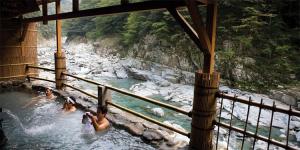More than 25,000 natural hot mineral springs are an important source of energy for Japan’s health-recovery tourism industry.
Located in a volcanic area on the Pacific Ocean, Japan is likened to lying on a “heating bed” with continuous geothermal activities. The country has more than 25,000 natural hot mineral springs that help provide the “life force” for more than 3,000 resort spas across the country.

Onsen in Japan often opens in an area with very beautiful scenery, so that bathers can both lie down and enjoy the scenery. (Photo: BBC).
Bathing in hot springs (onsen) is an important part of Japanese culture, with distinctive rituals that have been around for a long time. The following are basic guidelines for visitors having an onsen experience for the first time.
Depending on the facility, guests will have to shower with tap water or scrub with soap before entering the hot tub. It is best to bring your own soap, shampoo and towels.
Most onsen do not allow visitors to swim in swimsuits. At these spas, there are separate baths for men and women. You can use a towel to cover your body while on the shore. The purpose of this is to keep the water as clean as possible.
According to OnsenJapan, people with tattoos are traditionally understood to be in gangs or have ties to organized crime. Although this rule may seem discriminatory in this day and age, some onsen are still not open to visitors with tattoos.
Many onsen do not allow photography to ensure privacy. If you want to take pictures of the surrounding landscape, you must ask the resort staff first.
Guests are encouraged to drink bottled water for hygiene purposes. The most important thing is not to drink alcohol before taking a bath, partly because prolonged exposure to hot water when drunk can be dangerous to health.

Most of the Onsen will be divided into two areas: separate men and women. (Photo: Japan Times).
Bathing in mineral springs, which is considered a restorative therapy and medical treatment, has been widely used in Japan. Although often considered a “side therapy” , its benefits have been proven by prestigious medical studies around the world. The combination of chemistry, heat, and pressure of thermal baths is used to treat health problems such as dermatitis, arthritis or lower back pain.
The sulfur and magnesium found in the hot springs help promote skin health, while the heat can reduce symptoms of inflammation and pain, and boost the immune system. The onsen in Japan must have a temperature of at least 25 degrees Celsius, some even go up to 100 degrees Celsius.

Onsen bathing is a long-standing Japanese tradition. (Photo: Japan Times).
One of the most popular onsen sites in Japan is Kurama Onsen, a peaceful outdoor bath located less than an hour’s drive from downtown Kyoto.
Housed in a lovely, comfortable ryokan (traditional inn), Kurama Onsen offers a stunning mountain view surrounded by a forest of Japanese cedar trees.
Other popular traditional ryokan with hot spring baths include Gyozanen and Seryo, two beautifully designed resorts in Ohara, a rural district in northern Kyoto near Sanzenin temple.

